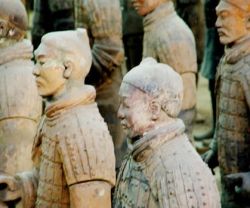Terracotta Warriors
Terracotta Warrior (兵马俑 Bīng Mǎ Yǒng) is a collection of terracotta made warriors and horses discovered in the mausoleum of Qin Shihuang (259BC-210BC), China's first emperor.
The sculptures were first discovered in 1974 in the Lintong District of the eastern suburbs of Xi'an, Shaanxi Province by a group of farmers who were digging a well at the foot of Mount Li. That discovery brought a group of archaeologists, who later unveiled the significance of the funeral scene with thousands of the terracotta warriors allegedly made by 700,000 craftsmen in the ancient era.
The State Council authorized the construction of a museum for the human-size sculptures in 1975. When completed, it became a popular tourist destination and an important landmark for Shaanxi Province. Covering an area of 16,300 square meters, the museum is divided into four pits. The No. 1 pit is the largest, paved with 11 corridors. There are approximately 8,000 figures inside the 230-meter pit. The No. 2 pit, opened in 1994, contains warriors and chariots of wood and is thought to represent a military guard. The No. 3 pit is a command center of "high ranking officials." The No. 4 pit is empty, uncompleted by its builders.
Work began on the sculptured army when Qin Shihuang was 13 years old, and the collection is considered one of the Wonders of the World.
